Epson R260 Printer ReviewCopyright Alain Briot. All rights reserved.
Introduction
The Epson R260 is an interesting printer because, as of November 2006, it features Epson’s latest ink and printhead technology, namely Epson’s new Claria inks and Epson’s new DX5 nozzle technology. Claria is a dye-base inkset with a reported longevity of 200 years while the DX5 printhead has the ability of generating 5 different ink droplet sizes, the smallest being only 1.5 picoliter.
The reason why I am reviewing this printer is because I know from experience that Epson introduces some of their latest technology in their line of desktop printers before implementing this technology in their professional printer line. Currently, Epson Pro printers are the 4800, 7800 and 9800, also called K3 in reference to the Ultrachrome version 3 inkset used in these printers.
I print all my work myself and I currently use Epson’s K3 printers. However, I like to review new ink technology to learn about the shape of things to come. Sometimes this technology makes it to the pro-printers line and sometimes it does not. At any rate it is always interesting to find out what cutting edge developments are available and what print quality it can produce.
If you own, or plan to purchase, an Epson Ultrachrome printer, either a desktop or a large format model, this review is probably of secondary interest to you. In that case look at it as a fun read and as an exploration of Epson’s latest ink and printhead technology. I am in this category myself, and purchased the R260 to test this latest ink technology. I also needed a desktop printer to print paperwork, and my R800, which served this purpose for several years, had been quite simply worn-out by Natalie and I. I thought that getting the R260 to replace it would allow me to kill two birds with one stone by providing Natalie and I with a new office printer and by allowing me to write this review.
On the other hand, if you are getting started in digital photography and are looking for a small and inexpensive printer with high print quality, then the R260 should be on your list. Desktop printers are of high interest to photographers who are not ready to step up to the cost and space requirements imposed by Epson’s pro-printers lines. Most of us, myself included, started with a desktop-size printer as our first printer.
Throughout this review I will be comparing the Epson R260 to the Epson R800. I reviewed the R800 previously and if you are interested in this other printer you may want to read my R800 review as well. The R800 is, in my mind, the closest competitor in the Epson printer line to the R260. As such, it is logical to compare the R260 to the R800.
Before I get started I do want to mention that I am not being paid to write this review and that I bought the Epson R260 that I am reviewing here with my own hard-earned money. The opinions expressed here are mines and mines only. I was not coaxed by Epson or anyone else in regards to writing this essay. Knowing me this would be hard to do anyway, but I wanted to mention it because I do receive emails asking about this.
Cost
Let’s start by looking at the cost of the R260. In one word: unbeatable. With tax or shipping (or both) the R260 is priced below $150. In fact, you may find it for around $130. $130 is the cost of a set of high-capacity ink replacement cartridges for the R260. Potentially, you could buy a new R260 printer each time the ink carts are empty and not spend any more money than if you bought a new set of ink cartridges. In fact, you could sell your used R260 printer on eBay and make a few extra dollars. You could potentially do this ad infinitum. I don’t recommend this approach but I have reflected upon its implications on more than one occasion.
If price is the deciding factor, then the R260 is a great choice. It’s direct Epson competitor, the R800, costs anywhere from $350 to $400, making the R260 much more affordable –by over one half- than the R800.
Ink Cartridges
You most likely noticed that in the paragraph above I mentioned “high capacity ink cartridges”. That is because the R260 gives you the choice of using either “regular size” ink cartridges or “high capacity” ink cartridges. The regular size carts are about $15 while the high capacity carts are about $20. According to Epson “high-capacity cartridges give about 50% higher yield for less than 24% greater cost.” I have not personally done tests to verify this but it does seem accurate, at least regarding cost and most likely also regarding yield.
The real question is how much larger are the high capacity cartridges? Well, Epson does not provide information about how many milliliters of ink are in their desktop-size ink cartridges, making this comparison difficult. All I know is that I ordered a complete set of high capacity cartridges and was shocked when, upon receipt, I noticed they were the same size as those that came with the printer. Yet, these High Capacity carts were smaller than the regular size carts that are used in the Epson R800! Apparently, the R260 ships with the high capacity cartridges, or at least mine did. Since these are smaller than the R800 carts I can only surmise how small the “regular” R260 carts are. I have not seen one yet, but what I can say is “stay away from the regular size R260 cartridges!”
Below is a photograph showing an Epson R800 cartridge on the left, and a high-capacity Epson R260 cartridge on the right. As you can see the size difference is noticeable (the thickness of the 2 carts is identical). The weight is also different, with the R800 cartridge being much heavier than the R260 cart. One can only surmise what Epson was thinking when they called R260 cartridges “High Capacity”!
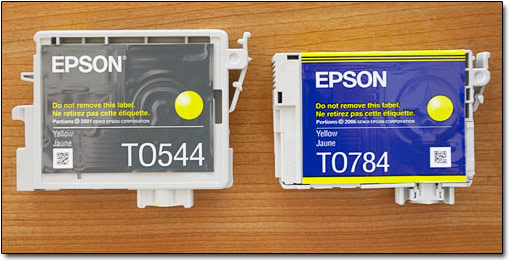
The R800 “regular size” $15 Yellow cart on the left with the R260 “High Capacity” $20 yellow cart to the right… What was Epson thinking? Is Claria ink so much more expensive to manufacture? Do I dare ask how much smaller the “regular size” R260 cart is?
|
Ink Cartridge serial numbers and details about the R260 inkset
The 77 series (such as serial number T077220 – cyan) indicate regular capacity cartridges while the78 series (such as serial number T078220 – cyan) indicate high capacity cartridges.
The R260 is a 6-color printer: cyan, light cyan, magenta, light magenta, yellow and black. It does not feature a gloss enhancer cartridge the way the R800 does and it only has one black cartridge. On the one hand one this may indicate a potential loss of print quality on glossy or matte papers. On the other hand it does save you money because you only need to replace 6 cartridges instead of 8.
Regarding the lack of the gloss enhancer, do keep in mind that the purpose of the Gloss Enhancer on the R800 is to enhance glossy print quality as well as add a waterproof and scratchproof coating onto the print. The Claria inks used in the R260 are already waterproof and scratchproof, making the use of the gloss enhancer redundant to some extent.
Printing on matte papers
Only one black ink is available in the R260. The R800 on the other hand features both matte black and photo black ink cartridges, allowing optimal print quality on both matte and glossy papers. My impression is that the R260 ink is optimized for both matte and glossy papers. The printer paper choice drop-down list features both glossy and matte papers although matte papers are listed as “Presentation Papers” (see the paper equivalence table below).
My tests on Epson Enhanced Matte, using the Matte Paper Heavy Weight canned profile that ships with the printer, resulted in a good print quality and vivid colors. My only complaint is that the blacks are a little softer than I would like them to be. However, with custom profiles it may be possible to get deeper blacks and thus a higher print quality on matte papers.
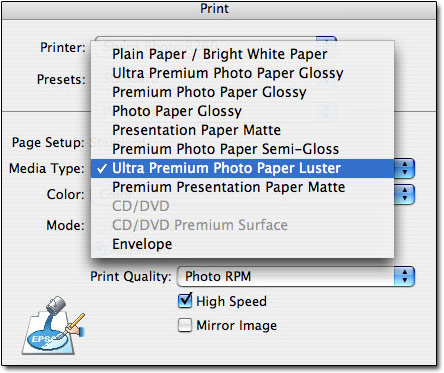
The R260 paper choice drop-down menu in the printer driver
|
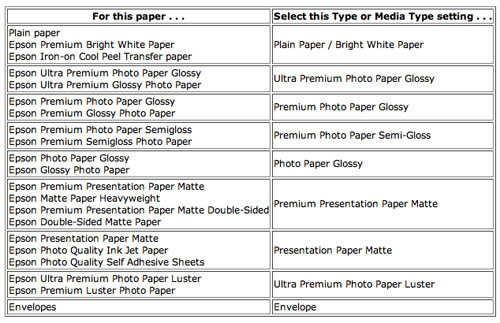
Paper choice equivalence chart. I found this chart on the Epson website in the Technical Support area of the R260
|
Black and white printing
There is no black and white printing mode on the R260 the way there is on some other Epson Printers. Black and white printing must be done through the provided profiles using the settings and controls used for color prints.
Built and quality
The R260 is a little smaller than the R800 and does not feature a roll feeder. There is also no straight-feeder making the use of heavier papers difficult. It may be possible to feed heavy papers through the regular feeder, but I have not tested that. CD and DVD printing is supported, though only in photo-quality mode, making CD printing longer than on the R800 which supports regular print quality on CDs.
The printer is slightly noisier than the R800 and makes a sharp noise when loading sheets of paper. At first that surprised me but, as with most things of this nature, I soon became used to it. Finally the printer has a more angular appearance than the R800 which features smooth curves, the way a 2007 Porsche Cayman compares to a 2007 Cadillac XLR Roadster. This comparison between these cars and printers stops at the superficial visual appearance of their design and does not extend into a comparison of their performances, the R800 and R260 being in an entirely different category than the Cayman and XLR Roadster. Finally, in case you wonder, my personal preference goes to the Cayman ;-)
Three printers, one technology
The R260 has two brothers (or two sisters if you prefer): the R380 and the R580. The R380, which costs $200, features a 3.5" color LCD on which you can see your photographs prior to printing. Nice, but not very useful if you optimize your photographs in Photoshop, or another software package, prior to printing, the way I recommend you do. The R580, for which a price is not available at this time but which will be priced higher than the R260 and R380, allows you to make scans and copies in addition to what the other two Claria printers can do. All three printers use the same inkset and printheads and therefore deliver the same print quality. Personally, I do not see a need for anything more than what the R260 has to offer. Your needs, of course, are likely to be different from mines.
Print head cleaning
The R260 does not offer automatic print head cleaning. It only offers the regular print test pattern (lines) with the option of doing cleaning cycles one at a time if the head is clogged. This is a serious lack in my estimate because the automatic cleaning mode is very practical and saves a lot of time by automating what can be, at times, a tedious process.
Profiles
The Epson R260 ships with the following eight “canned” profiles. Here is my translation of the cryptic names shown to the right:
- MPHW: Matte paper heavy weight
- PGPP: Premium glossy photo paper
- PGPS: Premium glossy photo smooth
- PLPP: Premium luster photo paper
- PQIJ: Photo quality inkjet paper
- PSPP: Premium semi gloss photo paper
- UPGP: Ultra premium glossy paper
These are the profiles I used in making my test prints with the R260. I did not create custom profiles, and this being a new printer I did not find ready-made profiles on the web from paper manufacturers other than Epson. I am sure these will become available later on.
Print Quality
This is the big one, isn’t it? After all, Epson claims that the R260 uses Claria dye-based ink, compared to the R800’s pigment-based ink, and this fact alone should increase the color gamut that the printer can deliver. Epson also claims that Claria ink and the DX5 printhead can deliver some of the smallest droplet sizes of any inkjet printer, as small as 1.5 picoliter. Epson also mentions that the R260 can vary the droplet size by a factor of 5 (hence the name DX 5), meaning that each printhead is capable of creating 5 different droplet sizes depending on the printer’s analysis of the print requirements. According to Epson, the R260 et al can “discern and adjust the ink droplet size based on the tonal values of every area of the print.”
Sounds good to me but how does it look on print? Well, let’s find out by looking at an actual print made on the R260.
The first thing I noticed when printing a fine art photograph on the R260 was that it printed a little darker than on the R800. I corrected that with a simple adjustment curve, as follows:

The adjustment curve I used for images printed on the R260 to compensate for a slightly darker print quality than on the R800 or on my Epson K3 Printers.
|
The second thing I noticed was the sharpness of the print. The print seemed sharper than prints done on other Epson printers, thereby validating Epson’s claim of superior sharpness from that printer. Of course, evaluating sharpness on a print is a subjective affair that is prone to errors. However, I asked Natalie to confirm my impression and we both agreed the prints had an uncommon sharpness to them.
The third thing I noticed was the color of the print. I had chosen, based on my color gamut evaluation of the printer’s color space, to print an image with lots of reds and yellows and few blues and greens, if any: Zabriskie Point (see my color gamut evaluation below in section 13). The resulting print, to my eyes and to Natalie’s eyes, had a richer color quality –or color gamut- than prints of the same image done on the R800 or on other Epson K3 printers.
So what are my conclusions in regard to print quality on the R260? Well, for one, I can say that prints do look sharper. Now what I made was an 8x10 print, so it remains to be seen how much sharper larger images would print. Unfortunately, because the R260 is a letter size printer, only a panoramic image, 8.5 inches wide by as long as the printer can accept, can answer this question. However, I do believe that there is a print sharpness gain when using the R260.
Regarding color, I do like the print color offered by the R260 even when using the “canned” profiles that are the only profiles I have at this time.
Is print color better on the R260 than on the R800? With reds and yellows it is, with greens and blues it is not. Why is that? Let’s wait until we discuss color gamut to answer this question (and answer it we will, I guarantee it). Before we do that, let’s take a look at print longevity.
Print Longevity
Another big one, isn’t it? After all, what is the point of creating great prints if they fade away? By definition, dye-based inks, as used in the R260, fade faster (much faster in some instances) than the pigment-based ink used in the R800 as well as in Epson’s K3 printers.
However, Epson claims a 200 year delay until “noticeable fading occurs” a commonly used terminology that defines when a print has faded to the point of this fading becoming noticeable. This claim is for framed photographs under glass. I have not verified it (come back and talk to me in 200 years) and neither has Wilhelm imaging, the authority when it comes to assessing image permanence.
So what is a photographer to do? Believe Epson’s claim for Claria Ink or go with the trusted longevity of Ultrachrome Pigmented ink? I really can’t answer that until I either test a Claria print myself or hear from someone who conducted such a test. My impression, and it is just an impression, is that Epson would not claim a print longevity of 200 years unless they had something to back it up with. Whether 200 years is fully accurate, or whether 100 or 150 year is closer to the mark, is hard to say. But the fact is that my impression, and again it is just an impression reached without having done any testing to support it, is that Claria may be the first dye-based inkset with archival qualities. In other words, if you believe Epson –and there is no reason to not believe them until proven otherwise—it is possible to create archival prints with the Claria dye-based inkset used in the R260, R380 and R580.
Color Gamut
Why is using a dye-based inkset so important? Why does it matter? After all why shouldn’t one simply play it safe and use a pigment-based inkset such as the one in the R800 or in Epson K3 Pro Printers?
The answer is color gamut. A dye-based inkset has a larger color gamut, most of the time, than a pigment-based inkset. The reason is due to the technology used in creating both types of inksets. I won’t go into it here, suffice to say that creating a large-gamut pigmented inkset is a real challenge.
One way to check the color gamut of a color device is by analyzing its color profiles in a color-graphing application. This is exactly what I did. Below are two graphs, created in Chromix ColorThink, in which the gamut of Claria ink as used in the R800 with Epson’s Premium Glossy Photo Paper profile is mapped against the gamut of the R800 Pigmented inset as described by the R800 Premium Glossy Photo Paper Profile:
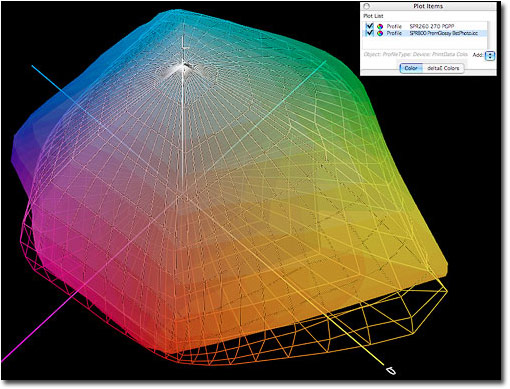
Chromix ColorThink Graph 1
|
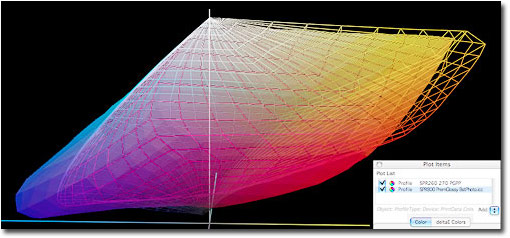
Chromix ColorThink Graph 2
In these two graphs, the wire frame represents the R260 gamut while the solid color represents the R800 gamut.
|
What can we tell from studying these two graphs? A number of things, eight to be precise:
- We can tell that the R800 has a larger blue and, to a lesser extent, a larger green color gamut, because the graph of the R800 extends further into blue and green than the graph of the R260.
- The R260 has a larger yellow and, to a lesser extent, red gamut than the R800, for the same reason as I just described.
- The R260 therefore gives us the ability to print a larger yellow and red gamut (read a larger number of yellow and red colors) but a smaller blue and green gamut, while the R800 gives us the ability to do the exact inverse.
- As a result what we gain in color gamut with the R800 we lose in the R260 and vice versa.
- If this was a perfect world it should be possible to combine the R800 and R260 gamut into a single gamut so that we have the largest color gamut in all colors.
- This is not a perfect world because doing so is impossible.
- If we believe what these graphs tell us we should then use the R800 when we are primarily concerned with printing a wide variety of greens and blues, and use the R260 when we are interested in obtaining the largest number of red and yellows.
- This isn’t as simple as we hoped it would be ;-)
Conclusion
So what are my overall conclusions regarding the R260? Should you buy it, should you buy the R800 or should you wait for the ideal printer? Here goes:
If money is the deciding factor for you, then by all means get the R260. At $150 maximum, including tax or shipping, you can’t go wrong because $130 represents the cost of a set of six “High Capacity” ink carts. The R800, in comparison, will set you back well over twice that amount. However, expect to spend more money on ink in the long run with the R260, especially if you print a lot, because the R260 carts are smaller than the R800 carts, regardless of the fact that Epson calls them “high capacity when in fact they are not. However, you will save money by having only 6 carts to replace on the R260 instead of 8 on the R800.
What should you make of image permanence if you get the R260? Well, look at it that way: if you display your images indoor, either matted, laminated or under glass, they will last possibly up to 200 years before noticeable fading occurs, and possibly over 100 if we are suspicious of Epson’s claims and slash their estimate in half. At any rate, we will all be long and gone by then, and only our descendents, or our client’s descendents, will be there to admire the results of our efforts.
More to the point, look at it this way: window glass stops well over 80% of UV light which is the wavelength that causes prints to fade and skin cancer to develop. This is why skin doctors commonly see patients who drive with their window down and who have skin cancer on their left arm (in the US, right arm in the UK).
What this means is that if you display your prints indoor, under glass or not, your prints will be protected from fading due to UV light. The good news is that this is how just about all of us display our work. Only a very small number of photographers display their work outdoors ;-)
What I am saying is that if Epson is truthful in their statement about Claria ink lasting 200 years, or even 100 years if we are suspicious, and we display our prints indoors, there should be little to worry about.
However, if you find that the above discussion keeps you up at night, and the extra cost of the R800 is OK with you, then you should get the R800. It will put your print longevity concerns to rest. Furthermore, independent testing results about R800 print longevity are readily available.
Finally there is the issue of color gamut. In my testing, printing images with lots of greens and blues on the R260, I have not noticed a huge loss, and often no loss at all, of colors in greens and blues. However, the profile study that I conducted does indicate that the R800 offers an extended color gamut in the blues and greens, and the R260 an extended gamut in the reds and yellows.
My advice in regards to color gamut is to look at how you feel regarding pricing, regarding dye inks versus pigmented inks, and finally regarding color gamut. If you find that the R260 is priced right for you and that you are OK with dye inks, then don’t worry about the color gamut. Unless your work consists essentially or blue-green tones or yellow-red tones, you have as many chances of losing blue-green colors on the R260 as you have of losing yellow-red colors on the R800! In that case you should just get the R260.
On the other hand, if you can afford a $400 printer, if you do not like dye ink and if you are kept up at night by concerns about image permanence, then you should get the R800. In some ways it is a more versatile printer than the R260 because of its larger ink carts and its roll and straight through feeders. The availability of numerous third party profiles is also a consideration.
Keep in mind that the R260 has the latest printhead technology resulting in prints that, to my eyes, are sharper than prints from other Epson printers. They also appear to be more vivid color-wise. I personally find R260 prints on luster or glossy paper remarkably good. The do regret that they cannot be made any larger than 8.5” wide since I like to print most of my work in large sizes.
Learn more about Alain and view more of his work on his website at www.beautiful-landscape.com. Alain can be contacted at alain@beautiful-landscape.com.
AB-NPN 2054
Comments on NPN nature photography articles? Send them to the editor.


| 


